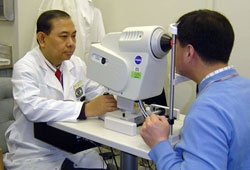Jan 12 2009
A compact fiber-optic probe developed for the space program has now proven valuable for patients in the clinic as the first non-invasive early detection device for cataracts, the leading cause of vision loss worldwide.
 Manuel B. Datiles III, M.D., NEI medical officer, demonstrates the dynamic light scattering (DLS) device. NEI and the National Aeronautics and Space Administration (NASA) collaborated to develop this simple, safe eye test for measuring a protein related to cataract formation.
Manuel B. Datiles III, M.D., NEI medical officer, demonstrates the dynamic light scattering (DLS) device. NEI and the National Aeronautics and Space Administration (NASA) collaborated to develop this simple, safe eye test for measuring a protein related to cataract formation.
Researchers from the National Eye Institute (NEI), part of the National Institutes of Health, and the National Aeronautics and Space Administration (NASA) collaborated to develop a simple, safe eye test for measuring a protein related to cataract formation. If subtle protein changes can be detected before a cataract develops, people may be able to reduce their cataract risk by making simple lifestyle changes, such as decreasing sun exposure, quitting smoking, stopping certain medications and controlling diabetes.
"By the time the eye's lens appears cloudy from a cataract, it is too late to reverse or medically treat this process," said Manuel B. Datiles III, M.D., NEI medical officer and lead author of the clinical study. "This technology can detect the earliest damage to lens proteins, triggering an early warning for cataract formation and blindness."
The new device is based on a laser light technique called dynamic light scattering (DLS). It was initially developed to analyze the growth of protein crystals in a zero-gravity space environment. NASA's Rafat R. Ansari, Ph.D., senior scientist at the John H. Glenn Research Center and co-author of the study, brought the technology's possible clinical applications to the attention of NEI vision researchers when he learned that his father's cataracts were caused by changes in lens proteins.
Several proteins are involved in cataract formation, but one known as alpha-crystallin serves as the eye's own anti-cataract molecule. Alpha-crystallin binds to other proteins when they become damaged, thus preventing them from bunching together to form a cataract. However, humans are born with a fixed amount of alpha-crystallin, so if the supply becomes depleted due to radiation exposure, smoking, diabetes or other causes, a cataract can result.
"We have shown that this non-invasive technology that was developed for the space program can now be used to look at the early signs of protein damage due to oxidative stress, a key process involved in many medical conditions, including age-related cataract and diabetes, as well as neurodegenerative diseases such as Alzheimer's and Parkinson's," said NASA's Dr. Ansari. "By understanding the role of protein changes in cataract formation, we can use the lens not just to look at eye disease, but also as a window into the whole body."
The recent NEI-NASA clinical trial, reported in the December 2008 Archives of Ophthalmology, looked at 380 eyes of people aged 7 to 86 who had lenses ranging from clear to severe cloudiness from cataract. Researchers used the DLS device to shine a low-power laser light through the lenses. They had previously determined alpha-crystallin's light-scattering ability, which was then used to detect and measure the amount of alpha-crystallin in the lenses.
They found that as cloudiness increased, alpha-crystallin in the lenses decreased. Alpha-crystallin amounts also decreased as the participants' ages increased, even when the lenses were still transparent. These age-related, pre-cataract changes would remain undetected by currently available imaging tools.
"This research is a prime example of two government agencies sharing scientific information for the benefit of the American people," said NEI director Paul A. Sieving, M.D., Ph.D. "At an individual level, this device could be used to study the effectiveness of anti-cataract therapies or the tendency of certain medications to cause cataract formation."
The DLS technique will now assist vision scientists in looking at long-term lens changes due to aging, smoking, diabetes, LASIK surgery, eye drops for treating glaucoma, and surgical removal of the vitreous gel within the eye, a procedure known to cause cataracts within six months to one year. It may also help in the early diagnosis of Alzheimer's disease, in which an abnormal protein may be found in the lens. In addition, NASA researchers will continue to use the device to look at the impact of long-term space travel on the visual system.
"During a three year mission to Mars, astronauts will experience increased exposure to space radiation that can cause cataracts and other problems," Dr. Ansari explained. "In the absence of proper countermeasures, this may pose a risk for NASA. This technology could help us understand the mechanism for cataract formation so we can work to develop effective countermeasures to mitigate the risk and prevent it in astronauts."